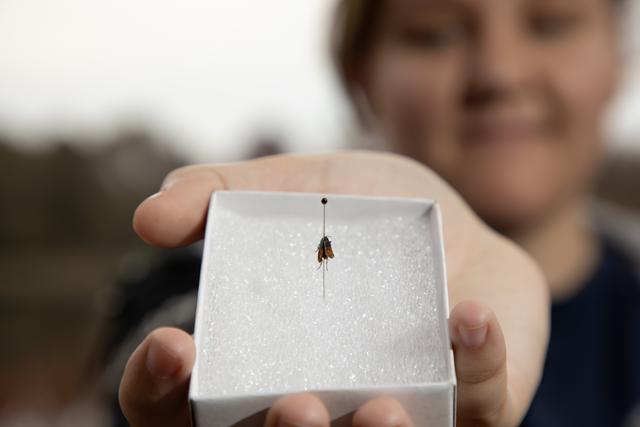Sarah Knapik spent a lot of time scouting around the storm drain at Lake Ceva this fall as she worked to build the bug collection needed for her entomology class. It paid off.
She found a Lepidotarphius perornatella — a colorful species of moth never before recorded in New Jersey. Native to East Asia, the moth had been recorded only once elsewhere in the United States: a sighting in Iowa in 2017.
Knapik, a biology major from South Amboy, will upload a description of the moth where it was located on the website bugguide.net and get credit for finding the species on the East Coast.
“I love organismal biology a lot,” said the senior, who plans to go to graduate school after her graduation from TCNJ this spring. “This has been a really interesting roller coaster,” she said.
When she couldn’t identify the moth she’d found, Knapik brought it to her professor, Mark Mayer, who contacted a former colleague in the New Jersey Department of Agriculture. Ryan Rieder, bureau chief of plant pest and disease control, was able to make the ID.
“This is really exciting,” said Mayer, an adjunct professor in the biology department and retired entomologist with the agriculture department’s insect lab. “It’s a really attractive little moth, really pretty. Two thirds of the wings are metallic green and the back part are orange with silver spots.”
The moth most likely came from Asia on a host plant. As little as two percent of shipping containers coming into the United States are inspected, Mayer noted. Spotted lantern flies, for example, came in on marble from China, he said. Thankfully, Knapik’s find is not believed to be an invasive species or so-called “actionable pest,” he said.
“Sarah is an excellent field biologist,” Mayer said. “There is a good chance that if you get down in the weeds, you’ll find something new.” At best, only about half of the estimated 2–5 million bug species in the world have been identified, he noted. “That’s why bugs are so cool.”
Knapik said she’s in her element whether hunting bugs and insects or caring for the snakes in the laboratory of biology professor Howard Reinert, where she is a herpetology research intern. “As we’re speaking, I have a snake on me,” she said during a phone interview from the lab. “They’re all sweethearts, they’re my babies.”
Read more about the find in this article from NJ.com.
— Patricia Alex


